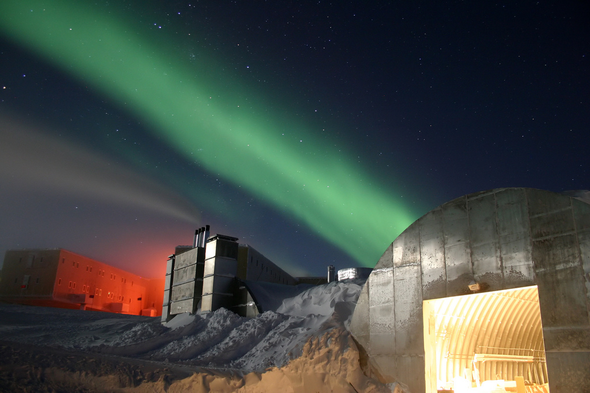Managing Data at the End of the World
Counterintuitive as it might sound, even in the coldest place on earth, overheating electronics remain a concern.
The air at the Geographic South Pole is simply way too frigid to blow over whirring servers there, says John Jacobsen, a Chicago software consultant. Vents can freeze shut or open and the air still has to be conditioned for the hardware.
In a video interview (embedded below) with tech-book publisher O'Reilly Media's James Turner, Jacobsen explained what it's like working with data in the South Pole, which can only be accessed by plane four months out of the year.
Jacobsen works with the IceCube project, which is building the world's largest detector of neutrinos, a kind of elementary particle that barely interacts with other particles. Think about it like this: photons of light can pass through a window, but not a wall. A neutrino, by contrast, can sail through the entire Earth, or a big chunk of the universe, without being reflected or absorbed.
Because they can travel such long distances unperturbed, neutrinos can be used to learn more about astronomical phenomena, such as exploding stars or black holes. But their lack of interactions also make them difficult to detect. You have to watch a huge volume of material to catch the odd collision between a neutrino and another particle. That's why the IceCube detector will capture data from a cubic kilometer of ice -- that's 35 billion cubic feet. Here's how it works:
We actually use large volumes of ice below the South Pole to watch for the rare neutrino that crashes into an atom of ice. This collision produces a particle--dubbed a "muon"--that emerges from the wreckage. In the ultra-transparent ice, the muon radiates blue light that is detected by IceCube's optical sensors. The muon preserves the direction of the original neutrino, thus pointing back to its cosmic source. It is by detecting this light that scientists can reconstruct the muon's, and hence the neutrino's, path.
Watching 35 billion cubic feet of ice generates a lot of data. On average, the project records roughly one terabyte of raw data per hour, all of which gets written to tape. The data is filtered and sent back daily over NASA's TDRSS satellite network, which the project shares with the agency's shuttles. It's stored in a Madison, Wisconsin data center, and copies are kept at data centers in Europe.
Flights to the South Pole are run by the New York Air National Guard, which doesn't like to fly in temperatures below 50 degrees Fahrenheit, Jacobsen says. That means that there are no flights for roughly eight months out of the year, so the project keeps plenty of spare equipment down there. "But you can always run out, and there's a danger that at some point you have to improvise or run with reduced capacity," he said. Jacobsen himself generally goes down for a month at a time in the summer months.
The tape drives on which all the raw data is written also suffer from their own weather-related problems. Because the humidity is "essentially zero," there's some risk of static buildup.
(via Slashdot)
Image: National Science Foundation/Chris Danals. The green light in the photo is the Aurora Australis. From the Flickr description of this 2005 photograph: "The new [South Pole] station can be seen at far left, power plant in the center and the old mechanic's garage in the lower right. Red lights are used outside during the winter darkness as their spectrum does not pollute the sky, allowing scientists to conduct astrophysical studies without artificial light interference."
><
